Canada Remembers Times - 2009 Edition - Page 2
Canadians Come Ashore on D-Day
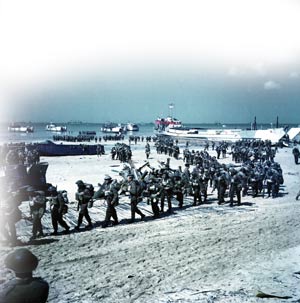
Canadian soldiers coming ashore at Juno Beach on D-Day.
Photo: Library and Archives Canada
In the early years of the Second World War, Germany occupied most of Western Europe. They built a string of formidable defensive positions along the Atlantic coast, transforming the continent into “Fortress Europe.”
The Allies planned “Operation Overlord” to liberate Western Europe—history’s largest combined (sea, land and air) invasion. On “D-Day,” June 6, 1944, British, American and Canadian forces came ashore in Normandy, France. Canadian paratroopers landed behind enemy lines in the pre-dawn hours, while approximately 15,000 Canadians began landing at “Juno Beach” later that morning. They pushed the farthest inland of any of the Allied forces that day. Thousands of Canadian sailors and airmen also participated in the invasion force, weakening the German defences and protecting the landing force from enemy counter-attack.
Nursing Sister Georgina Seeley of New Brunswick was working at a military hospital in England on D-Day. The day started quietly... but that would soon change.
“And can you believe that one minute we had not one patient. Twelve hundred empty beds with hot water bottles in them...I looked out the window, you could not see the end of the ambulances. [Soon] every bed was filled. Twelve hundred beds.”
The landings would be followed by almost a year of fierce fighting, taking the Canadian Army through France, Belgium and Holland, and liberating millions by the time the war in Europe officially ended on May 8, 1945.
Flying for Freedom
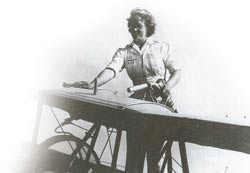
Canadian women contributed to the success of the BCATP as well, sometimes working as ground crew to keep the planes flying.
Photo: CFPU, PMR-75-361
To win the Second World War, the Allies needed to control the skies. Canada was selected as a major site of Allied aircrew training in 1939. It had the geographical space for a large training program, was out of range of enemy bombing and close to North American factories producing planes and needed equipment.
The British Commonwealth Air Training Plan (BCATP) saw construction of more than 100 airfields across Canada. More than 130,000 pilots, navigators, wireless operators, bombers, air gunners and flight engineers were trained by 1945. They came from the Commonwealth countries of Canada, Britain, Australia and New Zealand. Men from Poland, Norway, Belgium, Holland, Czechoslovakia and France were trained as well. It was dangerous work: more than 850 died, many buried in the communities where they had trained.
The BCATP was one of Canada’s most important and successful contributions to the war effort. It was a huge financial commitment for our young country. The new air bases created jobs and an economic boost in many towns. After the war, these airports would be key elements in the growth of civilian air service across the country. More than 3,700 of the airmen who came here to train married local women, many returning to live in Canada after the war.
NATO Marks 60 Years
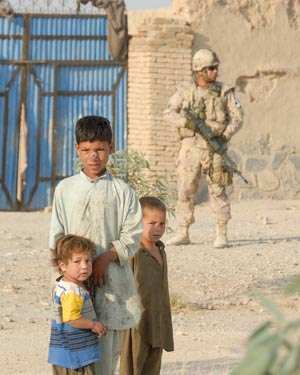
Canadian Forces members are in Afghanistan as part of a NATO force.
Photo: Department of National Defence. AR2007-Z030-02
After the Second World War, a new threat to world peace emerged. The Soviet Union and its Communist allies faced off against the United States, Canada and Western Europe for political and military dominance in the post-war world. Known as the “Cold War,” this tense showdown lasted from the mid-1940s to the early 1990s.
The Cold War dominated Canada’s military efforts for decades. The North Atlantic Treaty Organization (NATO) was founded in 1949 as an alliance of democratic countries who agreed to come to each other’s defence if any one of them was attacked. 2009 marks the 60th anniversary of this organization. Canada was one of the original 12 members of NATO, a number that has grown to 28 member countries.
Canada’s primary NATO contributions in Europe during the Cold War included an armoured brigade stationed in West Germany and a number of air force squadrons based in France (until the late 1960s) and West Germany. Today, the Canadian Forces contribute support and personnel to a variety of ongoing NATO training efforts and operations. Indeed, Canada’s current military efforts in Afghanistan are part of a larger United Nations-mandated NATO force.
The Canadian Red Cross: There for the Troops
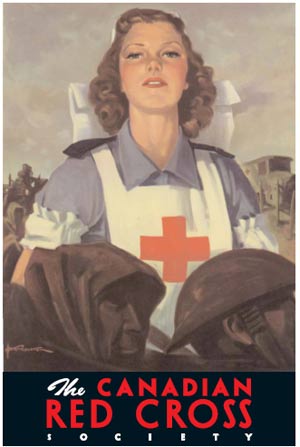
Reproduction of Second World War Canadian Red Cross poster.
Image: Courtesy of Canadian Red Cross
Those who served during the war years faced great hardships and Canadian civilians did their best to support them. Many Veterans would remember with gratitude the efforts of the Canadian Red Cross women.
During the Second World War, more than 15,000 Canadian women volunteered to serve on the home front and overseas with the Canadian Red Cross Corps. They supported patients and staff in military hospitals, drove ambulances, worked in administrative roles, helped civilians affected by the fighting, supported the families of military members and staffed hostels and canteens for military men. The Red Cross also distributed care packages for Allied prisoners of war.
Saskatchewan’s Grace Maynard helped former Allied prisoners of war on their release from enemy prison camps.
“Victory in Europe Day was spent in a camp among former prisoners of war. For many the war had been over for years but there were tears and hugs and much joy. An Irishman came over to me and we cried together when he said, ‘If only you knew how you people in the Red Cross saved our lives by sending us food parcels.’ I was told this over and over again.” *
After the war, Red Cross Corps volunteers also escorted war brides (European women who married Canadian servicemen) and their children sailing to Canada.
The year 2009 marks the 100th anniversary of the Canadian Red Cross. Canadian volunteers continue to serve overseas in international Red Cross efforts in places like Afghanistan.
* Quote taken from Women Overseas – Memoirs of the Canadian Red Cross Corps, edited by Frances Martin Day, Phyllis Spence and Barbara Ladouceur. Ronsdale Press, 1998.
Canada Remembers Theme Week

The largest youth forum in Canada invites you to join more than 100 young Canadians at the Terry Fox Centre in Ottawa for an incredible week of learning and exploring during the Canada Remembers Theme Week. You will hear Veterans’ personal stories, participate in experiential workshops, attend the National Remembrance Day Ceremony, visit the Canadian War Museum and lots more!
Discover the adventure at www.encounters-rencontres.ca.
Did You Know?
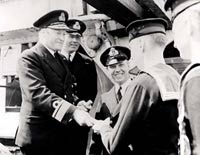
Rear Admiral L.W. Murray (left) presenting awards to crew members of destroyer HMCS St. Croix in 1942.
Photo: Library and Archives Canada. PA-037456.
Nova Scotia’s Leonard Murray entered naval college at 15, and served at sea during the First World War.
During the Second World War, Rear Admiral Murray, of the Royal Canadian Navy, was in charge of the Allied air and naval forces in the Northwest Atlantic Ocean. He was the only Canadian to command an Allied theatre of operations during the war, protecting the Merchant Navy convoys from deadly attacks by German U-boats (submarines). The convoys transported Allied troops and vital supplies from North America to Europe for the war effort.
- Date modified: